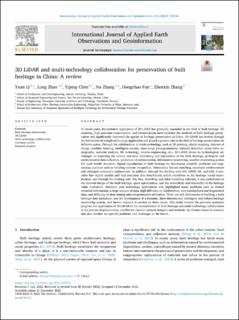| dc.description.abstract | In recent years, the technical application of 3D LiDAR has gradually expanded to the field of built heritage. 3D scanning, high-precision measurement, and reconstruction have enriched the methods of built heritage preservation and significantly improved the quality of heritage preservation in China. 3D LiDAR has broken through the limitations of a single technology application and played a greater role in the field of heritage preservation on different scales. Through the collaboration of multi-technology, such as 3D printing, digital mapping, internet of things, machine learning, intelligent sensors, close-range photogrammetry, infrared detection, stress wave tomography, material analysis, XR technology, reverse engineering, etc., 3D LiDAR shows its technological advantages on exploring the remote real-time monitoring and digitization of the built heritage, geological and environmental data collection, prediction of sedimentation, deformation monitoring, weather monitoring,system life cycle health detection, digital reproduction of built heritage for developing scientific problems and engineering practices such as building contour recognition, information feature matching, structural reinforcement and damaged component replacement. In addition, through the docking with GIS, HBIM, XR, and CIM, it provides fine digital models and high-precision data benchmarks which contribute to the heritage visual reproduction; and through the docking with 3Ds Max, SketchUp, and other modeling software, it has contributed to the renewal design of the built heritage, space optimization, and the scientificity and rationality of the heritage value evaluation. However, past technology applications also highlighted many problems such as limited recorded information, a large amount of data, high difficulty in collaboration, non-standardized and fragmented data, and difficulty in data mining and comprehensive utilization. There are still deficiencies in building a built heritage data backplane, and the development of a dynamic, three-dimensional, intelligent and refined heritage monitoring system, and further research is needed on these issues. This study reviews the previous academic progress and application of 3D LiDAR in the reconstruction of built heritage and multi-technology collaboration in the process of preservation, clarifies the current research hotspots and methods, the frontier issues of concern, and also clarifies the specific problems and challenges in the future. | en_US |

